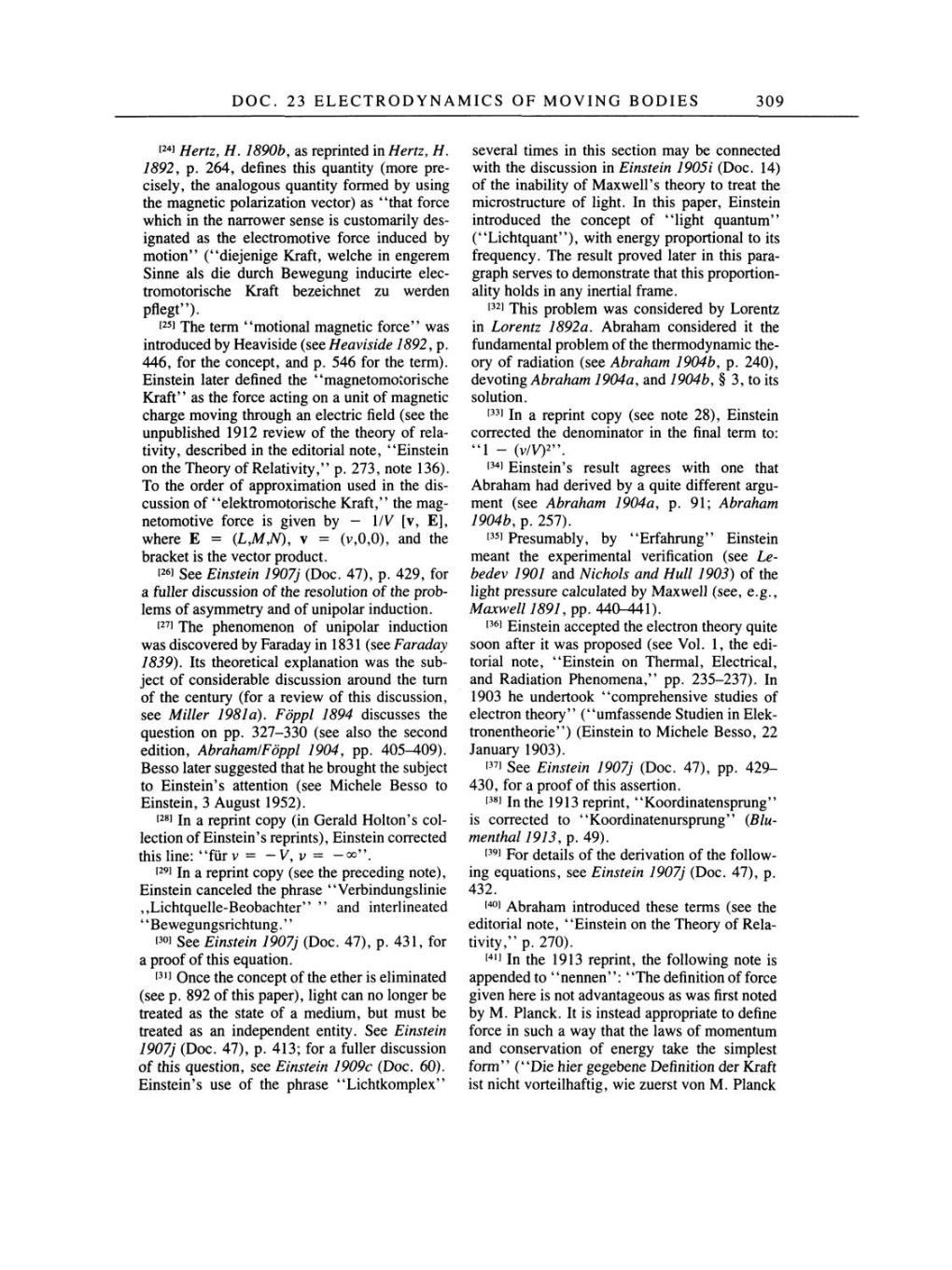DOC. 23
ELECTRODYNAMICS
OF MOVING BODIES 309
[24] Hertz,
H.
1890b,
as reprinted
in
Hertz,
H.
1892,
p.
264,
defines this
quantity
(more
pre-
cisely,
the
analogous quantity
formed
by using
the
magnetic polarization vector) as
"that
force
which
in the
narrower
sense
is
customarily
des-
ignated
as
the electromotive force induced
by
motion"
("diejenige
Kraft,
welche
in
engerem
Sinne als
die durch
Bewegung
inducirte elec-
tromotorische Kraft bezeichnet
zu
werden
pflegt").
[25]
The term
"motional
magnetic
force"
was
introduced
by
Heaviside
(see
Heaviside
1892,
p.
446,
for the
concept,
and
p.
546 for the
term).
Einstein later defined the
"magnetomotorische
Kraft"
as
the force
acting on a
unit
of
magnetic
charge moving through an
electric field
(see
the
unpublished
1912 review
of
the
theory
of
rela-
tivity,
described in the editorial
note,
"Einstein
on
the
Theory
of
Relativity,"
p.
273, note 136).
To the order
of
approximation
used in the dis-
cussion
of "elektromotorische
Kraft," the
mag-
netomotive force
is
given by
-
1/V [v,
E],
where
E
=
(L,M,N),
v
=
(v,0,0), and the
bracket
is
the vector
product.
[26]
See Einstein
1907j (Doc.
47),
p.
429, for
a
fuller discussion
of
the resolution
of
the
prob-
lems
of
asymmetry
and
of
unipolar
induction.
[27]
The
phenomenon
of
unipolar
induction
was
discovered
by Faraday
in
1831 (see
Faraday
1839).
Its theoretical
explanation was
the sub-
ject
of
considerable discussion around the
turn
of
the
century
(for
a
review
of
this
discussion,
see
Miller
1981a).
Föppl 1894 discusses the
question on pp.
327-330
(see
also the second
edition,
Abraham/Föppl 1904,
pp.
405-409).
Besso later
suggested
that he
brought
the
subject
to
Einstein's
attention
(see
Michele Besso to
Einstein,
3
August 1952).
[28]
In
a
reprint copy (in
Gerald
Holton's
col-
lection
of Einstein's
reprints),
Einstein corrected
this line:
"für
v
=
-
V,v
=
-s".
[29]
In
a
reprint
copy
(see
the
preceding
note),
Einstein canceled the
phrase
"Verbindungslinie
"Lichtquelle-Beobachter" "
and interlineated
"Bewegungsrichtung."
[30]
See
Einstein
1907j (Doc.
47),
p.
431,
for
a
proof
of
this
equation.
[31]
Once the
concept
of
the
ether
is
eliminated
(see
p.
892
of
this
paper), light can no longer
be
treated
as
the
state
of
a
medium,
but must
be
treated
as an independent entity.
See Einstein
1907j (Doc.
47),
p.
413;
for
a
fuller discussion
of
this
question, see
Einstein 1909c
(Doc. 60).
Einstein's
use
of
the
phrase
"Lichtkomplex"
several times in this section
may
be connected
with
the discussion
in Einstein 1905i
(Doc.
14)
of
the
inability
of Maxwell's
theory
to treat the
microstructure
of
light.
In this
paper,
Einstein
introduced the
concept
of
"light quantum"
("Lichtquant"), with
energy proportional
to its
frequency.
The result
proved
later in this
para-
graph
serves to
demonstrate that this
proportion-
ality
holds in
any
inertial frame.
[32]
This
problem was
considered
by
Lorentz
in Lorentz 1892a. Abraham considered it the
fundamental
problem
of
the
thermodynamic
the-
ory
of
radiation
(see
Abraham
1904b,
p.
240),
devoting
Abraham
1904a, and
1904b,
§
3, to
its
solution.
[33]
In
a reprint copy
(see
note
28),
Einstein
corrected
the denominator in the final
term to:
"1
-
(v/V)2".
[34]
Einstein's
result
agrees
with
one
that
Abraham had derived
by a quite
different
argu-
ment (see
Abraham
1904a,
p.
91;
Abraham
1904b,
p.
257).
[35] Presumably,
by
"Erfahrung"
Einstein
meant
the
experimental
verification
(see
Le-
bedev 1901 and Nichols
and Hull
1903)
of
the
light pressure
calculated
by
Maxwell
(see, e.g.,
Maxwell
1891,
pp.
440-441).
[36]
Einstein
accepted
the electron
theory quite
soon
after
it
was proposed
(see
Vol.
1,
the edi-
torial note,
"Einstein
on
Thermal, Electrical,
and
Radiation Phenomena,"
pp.
235-237). In
1903 he undertook
"comprehensive
studies of
electron
theory"
("umfassende Studien in
Elek-
tronentheorie")
(Einstein
to
Michele
Besso,
22
January 1903).
[37]
See Einstein
1907j (Doc. 47),
pp.
429-
430,
for
a
proof
of
this assertion.
[38]
In the 1913
reprint,
"Koordinatensprung"
is
corrected
to "Koordinatenursprung"
(Blu-
menthal
1913,
p.
49).
[39]
For details
of
the derivation
of
the follow-
ing equations,
see
Einstein
1907j
(Doc.
47),
p.
432.
[40]
Abraham introduced these
terms (see
the
editorial
note,
"Einstein
on
the
Theory
of
Rela-
tivity,"
p.
270).
[41]
In the 1913
reprint,
the
following
note
is
appended to
"nennen": "The
definition
of
force
given
here
is not
advantageous as
was
first noted
by
M.
Planck. It
is
instead
appropriate
to define
force in such
a way
that the laws of momentum
and
conservation of
energy
take the
simplest
form"
("Die hier
gegebene
Definition
der
Kraft
ist nicht
vorteilhaftig,
wie
zuerst
von
M.
Planck
